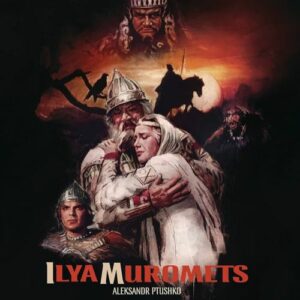Ilya Muromets (1956)
| Description | |
|---|---|
| Country of Origin | Soviet Union |
| Language | Russian |
| Genre | Adventure, Fantasy |
| Cast | Boris Andreyev, Shukur Burkhanov, Andrei Abrikosov, Natalya Medvedeva, Yelena Myshkova |
| Directed by | Aleksandr Ptushko |

The 1956 Russian film Ilya Muromets, directed by Aleksandr Ptushko, is a grand cinematic retelling of one of Russia’s most enduring folk legends. Rooted deeply in the bylina (oral epic tradition) of Slavic mythology, the film brings to life the adventures of Ilya Muromets, a bogatyr (warrior-hero) of Kievan Rus. The movie is remarkable not just for its ambitious storytelling but for its depiction of mythological elements that shaped medieval Russian folklore.
One of the film’s greatest strengths is its faithfulness to the mythic structure of Ilya Muromets’ tale. The protagonist, a disabled peasant who gains superhuman strength after drinking a miraculous elixir from wandering pilgrims, follows the classic hero’s journey. This transformation mirrors numerous mythological tropes, including divine intervention and the bestowal of supernatural powers, akin to figures in other global mythologies. His rise from an ordinary man to a protector of Kievan Rus reflects the idealized warrior archetype seen in many cultures.
The film also incorporates legendary creatures and supernatural beings, most notably the fearsome three-headed dragon Zmey Gorynych. This creature is one of the most recognizable figures in Slavic mythology, often representing chaos and destruction. Its portrayal in the film, though limited by the special effects of the time, remains an impressive attempt to visualize an entity that had existed primarily in oral tradition and medieval illustrations. The presence of nightmarish Tugarin Zmeyevich, a composite of various mythical antagonists, adds another layer of folklore authenticity, embodying the archetypal shape-shifting and fire-breathing villain of Slavic epics.
The concept of divine justice, a recurring theme in Russian folklore, plays a central role in Ilya Muromets’ journey. The hero’s unwavering loyalty to Prince Vladimir, ruler of Kiev, mirrors the folkloric emphasis on duty and service to the homeland, reflecting a broader mythological narrative where the hero acts as a guardian against foreign invaders and evil forces. The film dramatizes this idea through grand battles and tests of strength, reminiscent of ancient epics like The Iliad or Beowulf, reinforcing Ilya’s status as a mythic protector rather than just a military figure.
Visually, Ilya Muromets draws heavily from Russian artistic traditions, particularly iconography and medieval illustrations. The grand, stylized set designs, costumes, and battle sequences create a world that feels both legendary and historically inspired. The cinematography often frames the hero in ways that evoke religious imagery, positioning him as a quasi-divine savior in line with traditional depictions of warrior saints. The exaggerated scale of action sequences, including the massive armies and mystical elements, further emphasizes the larger-than-life nature of the myth being told.
Ultimately, Ilya Muromets is a film that successfully captures the spirit of Russian folklore, weaving together legendary creatures, heroic archetypes, and moral themes central to the Slavic epic tradition. While it may feel dated in terms of effects and pacing, its mythological richness and commitment to authenticity make it a fascinating cinematic representation of one of Russia’s greatest folk heroes.




